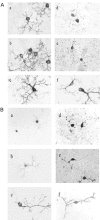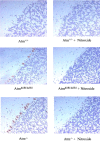Oxidative stress is responsible for deficient survival and dendritogenesis in purkinje neurons from ataxia-telangiectasia mutated mutant mice
- PMID: 14673010
- PMCID: PMC6740509
- DOI: 10.1523/JNEUROSCI.23-36-11453.2003
Oxidative stress is responsible for deficient survival and dendritogenesis in purkinje neurons from ataxia-telangiectasia mutated mutant mice
Abstract
Atm gene-disrupted mice recapitulate the majority of characteristics observed in patients with the genetic disorder ataxia-telangiectasia (A-T). However, although they exhibit defects in neuromotor function and a distinct neurological phenotype, they do not show the progressive neurodegeneration seen in human patients, but there is evidence that ataxia-telangiectasia mutated (Atm)-deficient animals have elevated levels of oxidized macromolecules and some neuropathology. We report here that in vitro survival of cerebellar Purkinje cells from both Atm "knock-out" and Atm "knock-in" mice was significantly reduced compared with their wild-type littermates. Although most of the Purkinje neurons from wild-type mice exhibited extensive dendritic elongation and branching under these conditions, most neurons from Atm-deficient mice had dramatically reduced dendritic branching. An antioxidant (isoindoline nitroxide) prevented Purkinje cell death in Atm-deficient mice and enhanced dendritogenesis to wild-type levels. Furthermore, administration of the antioxidant throughout pregnancy had a small enhancing effect on Purkinje neuron survival in Atm gene-disrupted animals and protected against oxidative stress in older animals. These data provide strong evidence for a defect in the cerebellum of Atm-deficient mice and suggest that oxidative stress contributes to this phenotype.
Figures




References
-
- Barlow C, Hirotsune S, Paylor R, Liyanage M, Eckhaus M, Collins P, Shiloh Y, Crawley JN, Ried T, Tagle D, Wynshaw-Boris A ( 1996) Atm-deficient mice: a paradigm of ataxia telangiectasia. Cell 86: 159-171. - PubMed
-
- Barlow C, Ribaut-Barassin C, Zwingman TA, Pope AJ, Brown KD, Owens JW, Larson D, Harrington EA, Haeberle AM, Mariani J, Eckhaus M, Herrup K, Bailly Y, Wynshaw-Boris A ( 2000) ATM is a cytoplasmic protein in mouse brain required to prevent lysosomal accumulation. Proc Natl Acad Sci USA 97: 871-876. - PMC - PubMed
-
- Boder E ( 1985) Ataxia-telangiectasia: an overview. In: Ataxia-telangiectasia genetics, neuropathology, and immunology of a degenerative disease of childhood (Gatti R, Sibt M, eds), pp 1-63. New York: Alan R. Liss.
Publication types
MeSH terms
Substances
LinkOut - more resources
Full Text Sources
Other Literature Sources
Medical
Molecular Biology Databases
Research Materials
Miscellaneous
